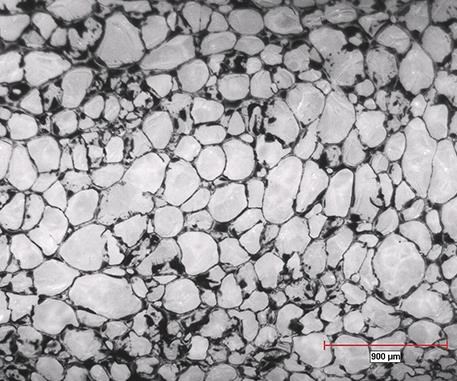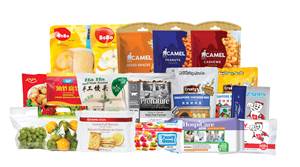U.S. High-Melt-Strength PP Tackles Wide Range of Applications
Total’s new HMS-PP signals both increased interest in the material and a source of domestic production.
Houston-based Total Petrochemicals & Refining USA, Inc. has begun producing high-melt-strength (HMS) PP for use in a gamut of applications, including low-density foam extrusion, large-part blow molding and thermoforming, profile extrusion, and extrusion coating.
Developmental HMS-PP, made by a proprietary technology, is available in commercial quantities from Total’s LaPorte, Tex., site, an integrated 2.3-billion/lb PP facility producing a wide range of homo- and copolymers. Total appears to be the first supplier to manufacture HMS-PP resin in North America. HMS PP resin has been imported from Austria’s Borealis (U.S. office in Port Murray, N.J.).
“We are seeing increasing activity in the U.S. involving HMS-PP,” says Mike Musgrave, marketing manager for TPRI Polymers Americas. “We view it more as a specialty resin and new for us here in the U.S., targeting both disposable and durable packaging.”
FOAMS & MORE
Polypropylene’s inherent chemical resistance and thermo-mechanical properties, plus the higher melt strengthof this version, suit it to producing high-performance technical foams for specialty packaging, such as protective packaging for electronics and medical devices, as well as automotive components and consumer products such as sports helmets. Durable, low-density foams made with this HMS-PP offer superior recyclability, notes Musgrave, making it a contender for foam applications currently dominated by crosslinked PE, PVC, and PUR.
Total’s high-melt-strength PP can produce closed-cell foams via direct gassing, for instance with butane or CO2, having very low densities—0.05 to 0.250 g/cc, and superior mechanical and aesthetic properties.
Besides foams, Total sees the material as a challenger in other processes:
• Large-part blow molding: Uses such as vessels or drums larger than 5 liters (1.32 gal), where HDPE is typically used, but where both chemical and high-temperature resistance are required.
• Large-part thermoforming: Applications that traditionally use ABS or HIPS, such as refrigerator liners, small boat hulls, and reusable materials-handling bins, where use of PP was not possible due to low melt strength.
• Extrusion coating: Extruding HMS-PP onto a woven fabric or paper, where it could replace PE because of its better heat resistance, and potential for greater line speeds.
• Profile extrusion: Applications could include building and construction, such as an alternative to PVC window profiles or HDPE pipe.
PERFORMANCE PROPERTIES
Total Polymers Americas product development managers Leonardo Cortes and Ken Blackmon are presenting a paper on the new HMS-PP this month (Feb. 21-24) at the SPE International Polyolefins 2016 conference in Houston. In comparing their HMS-PP to a standard PP, they show that the HMS-PP has increased rheological breadth (shear thinning), higher melt strength, and significantly higher elasticity.
Foam extrusion evaluations comparing Total’s new HMS-PP to an existing commercial HMS-PP show similar foam densities and closed-cell contents. However, the authors note that the two products process differently and may not be interchangeable in any particular application. Therefore, processors likely will need to optimize foam extrusion conditions and/or formulation for specific HMS-PP materials.
The authors also show that lab-scale evaluations with Total’s HMS-PP could achieve foam densities down to 0.1 g/cc with a high level of closed cells, similar to the range achieved with the commercially available HMS-PP.
Most notably, Total’s research shows that foams produced with the new HMS-PP have considerably higher stiffness, as well as a smoother and glossier surface, than foams produced with the existing commercial competitor. The company sees these characteristics opening opportunities for development of new foam applications that require excellent rigidity and superior appearance.
According to the authors, foam extrusion is of particular interest, as polyolefin foams are the fastest growing category of foams globally. Extruded PP foams, in particular, are projected by industry studies to grow at an annual 6.9% rate for the next five years.
Related Content
The Fundamentals of Polyethylene – Part 2: Density and Molecular Weight
PE properties can be adjusted either by changing the molecular weight or by altering the density. While this increases the possible combinations of properties, it also requires that the specification for the material be precise.
Read MorePolyethylene Fundamentals – Part 4: Failed HDPE Case Study
Injection molders of small fuel tanks learned the hard way that a very small difference in density — 0.6% — could make a large difference in PE stress-crack resistance.
Read MoreFlexible-Film Processor Optimizes All-PE Food Packaging
Tobe Packaging’s breakthrough was to create its Ecolefin PE multilayer film that could be applied with a specialized barrier coating.
Read MoreFirst Quarter Looks Mostly Flat for Resin Prices
Temporary upward blips don't indicate any sustained movement in the near term.
Read MoreRead Next
Making the Circular Economy a Reality
Driven by brand owner demands and new worldwide legislation, the entire supply chain is working toward the shift to circularity, with some evidence the circular economy has already begun.
Read MoreLead the Conversation, Change the Conversation
Coverage of single-use plastics can be both misleading and demoralizing. Here are 10 tips for changing the perception of the plastics industry at your company and in your community.
Read More























